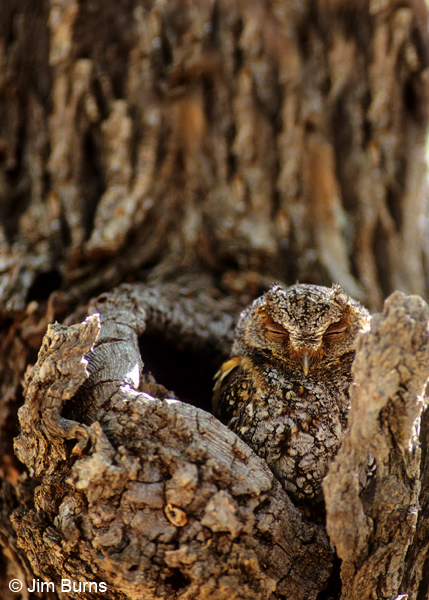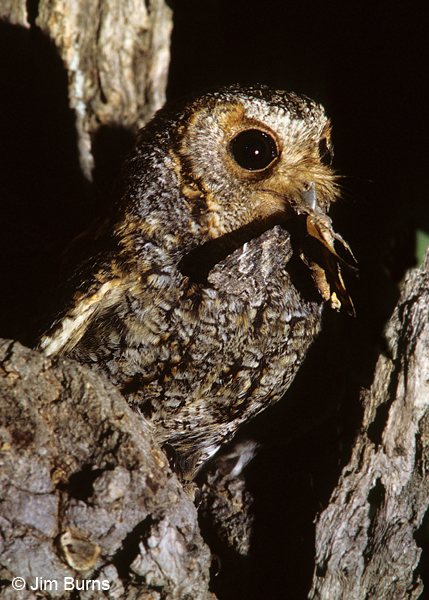
In his species account of Flammulated Owl in The Birds Of North America, Arch McCallum makes the statement that it is "the most common raptor of the montane pine forests of the Western United States." This will come as a shock to every birder who has stumblestepped through nightdark woods hooting and listening for Flams without ever hearing, let alone seeing one. I can attest to this little owl's existence because I have photographs, but I can relate. Flammulated was one of the last North American owls we saw, and it was easily the most frustrating.
There are several factors that play a role in the difficulty birders have finding and seeing this species, and it all begins with this little owl's vocals. Most birders locate most of their owls after hearing them first. Good luck hearing a Flam. The primary call of the male, the call used to advertise territory and the one heard on most owl tapes, is a single, soft, low-pitched note generally transcribed as "Boo" and repeated, sometimes endlessly, every three to four seconds. The closest owl sound to this comes from Long-eareds. Such a low frequency from such a small bird is attributed to Flammulateds' relatively large tracheal diameter. These soft hoots supposedly travel up to 800 yards. Yeah, right. Maybe under perfect conditions on a calm night. But they are ventriloquial and the amplitude is lowered whenever interlopers are detected in the territory. The net effect is that Flams are always much closer than they sound and their location is nearly impossible to pinpoint.
Of course, if you do happen to pinpoint that location, you'll be trying to see a small owl. Really small. Only our Elf Owl is smaller. Flammies are smaller than the three screech-owls with which they share the Otus genus, they are smaller by weight than our two pygmy-owls, and--picture this comparison in your mind--they are smaller than several of our sparrows! And their preferred habitat is open ponderosa pine forest with an oak understory. Now picture what ponderosa bark looks like and remember the common name, "Flammulated," is derived from the diminutive of the Latin flammeus which means "flame-colored." This owl has enough rich rufous highlights in the facial disc and along the scapulars to blend perfectly (maddeningly) into the reddish interstices of the ponderosa bark. Tiny owl, huge trees, perfect protective coloration. This is why Flams are heard much more often than they are seen.
If you need more reasons why your chances of seeing a Flammulated are limited, consider these. Flams are strictly nocturnal, most active in the hour after sunset and the hour before sunrise (you have to be in the woods after dark). Flams are our only small owl with dark eyes (your flashlight won't reflect off the iris as it does with the other small owls). Flams' preferred daytime roost is the densest vegetation it can find (are you feeling lucky?). Flams are thought by some to be colonial nesters (large tracts of seemingly appropriate habitat will by uninhabited). Flams are highly migratory so there is only about a six-month window to see them in North America (there are only three winter records of this owl north of the Mexican border).
Flammulated Owls nest from southern British Columbia southward into Mexico, withdrawing in winter from the northern portions of this range into Central America. Little is known about Flam migration except that it takes place at night. Migration is certainly corollary to "Little Flame's" evolution as a 100 percent insectivorous species, with relatively small feet and weak talons not evolved to prey on rodents. Typical Flammulated fare includes nocturnal moths, beetles, crickets, and grasshoppers, prey which does not survive winter in the high country of North America. It is thought that fall migration in September and October follows the mountains, but the return in April, when insects are still scarce at higher elevations, passes through the lowlands and valleys.
In North America Flammulateds are typically found in pine/oak associations above 5000 feet, but will utilize aspen and fir in northern states and in southern Arizona's "sky islands" may intersect with Elf Owls in lower montane canyons. Flams are monogamous, males returning first followed by the females, typically to their territory of the previous year. Nest sites are generally not reused from year to year. Favored sites are old woodpecker holes or natural cavities in dead snags, the former usually in pines, the latter in the oak understory. Reproductive rates for Flams are low compared to other owls, two to three eggs per clutch, but breeding success rates are high for such a small bird. Mammalian nest predation is most commonly carried out by squirrels, and the most common avian predators on adult Flammulateds are the usual suspects: larger owls and accipiters.
As recently as 1980, The Audubon Society Encyclopedia Of North American Birds characterized Flammulated Owl as "rare and local." What, you don't believe anything has changed? Let me give you some hope. The first half dozen times we went owling specifically for Flams, we heard and saw zero. On our seventh try we were finally successful . . . sort of. After getting a response to our calls, we had spent half an hour trying to pinpoint the owl's location amidst tall pines when our efforts were interrupted by a bear. Bears have a way of crystallizing your priorities. We didn't see our first Flam that night.
But here's some hope. Sometimes Flams find you! It was in July of the following summer in the Bradshaw Mountains of central Arizona, Flammulated Owls the farthest thing from our minds, 10 p.m., the pines dripping from the passage of a crackling monsoon thunderstorm. Large green beetles with striking cream antennae were pinging off our camp lantern, shadows of wind whipped branches playing through the light. Suddenly, without warning, one of the shadows became shape, perfectly intersecting beetle's flight on silent wing. Flashlight beam followed this flying wraith to a horizontal bough where it landed. FLAM!
Smaller, lower, and closer than it had ever been in our imaginations over the years, this little owl plied its trade around our campsite for half an hour, oblivious to our presence. We learned a lot about Flams that night. If you're really close, you'll realize the call is actually two-noted, "boo-BOOT." Prey is located visually and captured on the wing, in beak or claw, or hover-gleaned from pine needles and branch tips. Flam wings, like those of our daytime flycatchers, are relatively long and pointed which facilitates hovering but limits maneuverability which, in turn, would seem to account for Flams' preference for open forest.
Here's more hope. Since that summer night we've encountered several Flams, all when we were actually looking for them. Doesn't it always seem to go that once you've found an elusive species you intuitively know better how and where to look. Besides, remember this is "the most common raptor of the montane pine forests of the Western United States." Know also that some research indicates Flams are more plentiful in wet weather cycles. More insects, more Flams. This is important information for you non-believers. The ten-year drought in the west appears to be over, meaning Flams should be easier to find now than in recent years. Raise your hand if you'll be out there looking. That's what I thought.
